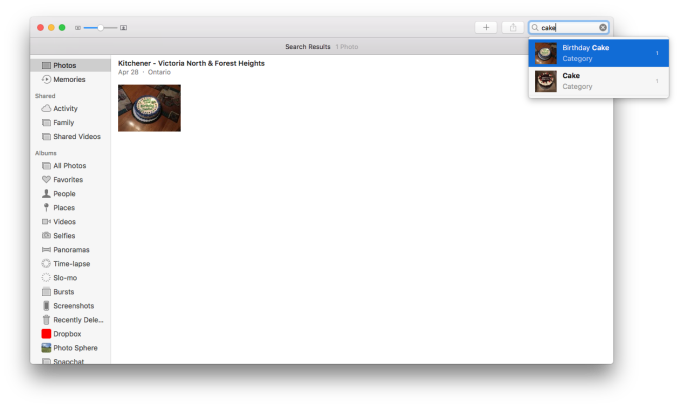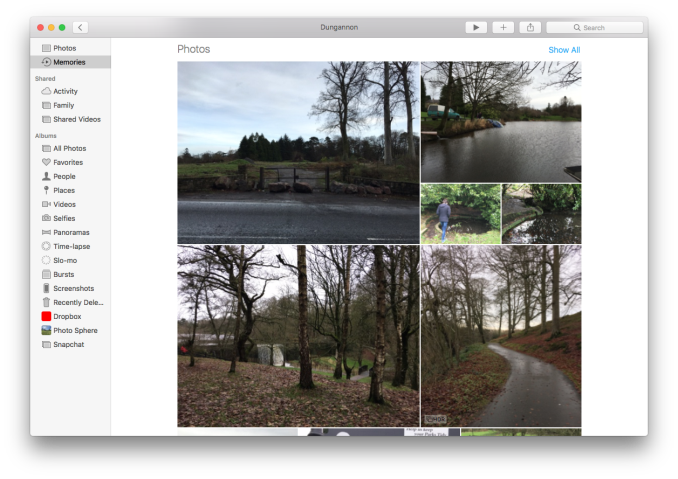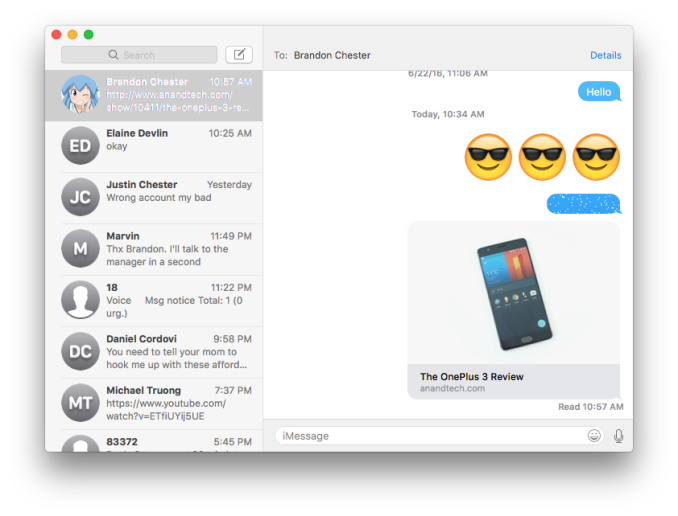A First Look At Apple's macOS Sierra
by Brandon Chester on July 13, 2016 8:00 AM EST- Posted in
- Mac
- Apple
- Operating Systems
- macOS
Photos
The Photos application for OS X was unveiled alongside OS X Yosemite, but while Yosemite launched in the second half of 2014 it wasn't until mid-2015 that the Photos app was officially released. Photos provided a great way to organize all the photos that users take on their iOS devices, and integration with iCloud and the new iCloud Photo Library was clearly something kept in mind during the development process, while Apple's previous attempt to integrate iCloud into iPhoto using Photo Stream felt like a tacked on feature.
While Photos and iCloud Photo Library provide a simple way to make photos accessible across all Apple devices, they haven't done much to help with organizing those photos. Apart from the most basic categorization like automatic albums for panoramas, selfies, burst photos, etc, the only automatic detection based on the content of a photo is the Faces album which tries, not always successfully, to generate an album containing photos where people's faces are visible. Around the same time, Google launched Google Photos, which employs machine learning to do image analysis which enables categorization and search on sets of photos based on the contents of the photos themselves.
With Photos for macOS Sierra and iOS Apple is now employing machine learning as well. Much like Google Photos, you can now search for photos based on the content within them, and the app will now generate groupings of photos that are related. The search generally works as expected, although there are limitations to what sort of objects the system has been trained to recognize. The most interesting situation I found was the one above, where it correctly distinguished between a normal cake and a birthday cake and presented two separate search results where the birthday cake result had only the cake images where the happy birthday text writting in icing was visible.
For photo organization there's a new feature called Memories. These are essentially groupings of photos that are related based on context and metadata. At this point the feature has only generated one memory for me, but I have a number of images from trips and events in my iCloud Photo Library and I'm not sure why it hasn't generated one for those as well. The memory it did generate was of my trip to Ireland and Northern Ireland, and it grouped the photos taken at a park there by me and a friend of mine.
Apple also has a new editing option called Brilliance. This setting essentially works to improve the exposure of an image selectively by brightening darker areas but leaving properly exposed areas as they are. For instance, it may lighten a harsh shadow significantly while only slightly adjusting the well-lit area. This slider can be thought of as one that automatically applies the other adjustments that are available individually in order to achieve a certain result. I don't do any photo editing in the macOS or iOS Photos apps, but I suppose that the ultimate goal with consumer photo editing has been making a single-action system for fixing issues with images, with Brilliance being like a more fine-grained version of one click auto adjustment features.
Messages
At WWDC there were a number of new features shown for the Messages application on iOS that will be coming in iOS 10. Given that iMessage exists on both iOS and macOS, it makes sense that support for these features is coming to Sierra as well. The situation isn't as simple as one might think, as while you can receive messages using all the new features on a Mac, you can't send messages that make use of features provided by iMessage apps, and you can't use some of the features that were designed for the multi-touch interface of iOS.
The core interface of Messages is pretty much unchanged. Right now Apple has changed the default contact avatar, but these kinds of changes often change multiple times over the course of the iOS and macOS beta cycle. In the screenshot above you can see Apple's new 3x emoji. When sending emoji alongside text the message renders at its typical size, so this just applies to messages that only have emoji in them. The display of messages that have links is also much better. Previously they simply displayed the link as text, which felt really antiquated compared to apps like Skype and Hangouts that give you a preview, and now iMessage does the same.
Messages for macOS includes support for the new message effects that will be coming in iOS 10. There are effects to make messages that scale up in size to emphasize loudness, or come in with the text obscured until you wipe the effect away to reveal the text. You can receive these messages on macOS, but you cannot apply them to the messages that you send.
The one feature that does make its way to macOS is support for placing a reaction on a message. By long clicking on a message you open a menu that has a number of responses. Applying one of these to a message applies an icon on the corner of the message corresponding to the reaction, and options like the humor reaction provide a good way to cut down on the number of messages that simply say "lol".
I do feel that Apple could have found a way to implement more of the new iMessage features in the macOS Messages app. For example, you could implement message effects on macOS with a simple tooltip menu or a popover, even if the interface still does work better within the multitouch interface of iOS. On the other hand, when I send messages on macOS I tend to just type it in and hit enter to send, and I probably wouldn't end up using the message effects as much as on iOS due to the greater friction in the interface. I can see how the decision may have come down to weighing the balance between the engineering effort required and how well it would actually work on a desktop or laptop.














81 Comments
View All Comments
Wheaties88 - Wednesday, July 13, 2016 - link
Any chance of being able to just clone a copy of macOS Sierra onto the drive of a non-supported Mac and getting it to boot?DPUser - Wednesday, July 13, 2016 - link
http://forums.macrumors.com/threads/mac-pro-3-1-in...Wheaties88 - Wednesday, July 13, 2016 - link
Thanks. I might have to try that on an older MacBook I have.casperes1996 - Thursday, July 14, 2016 - link
So, just to clarify something.The PiP window doesn't have to snap to the corners of the screen. It's just the default behaviour. If you drag it around while holding command, the floating window can be placed anywhere.
Furthermore, there's also a new, unmentioned window management feature; Snapping. It's not like the Aeuro snap thing on Windows, but moving a window to the edge of another, or resizing it or something, will result in the window, sort of magnetically sticking slightly when it reaches the edge of the other window, or the boundary of the screen. It can still be stretched beyond that point, but it's faster and easier to line things up exactly edge to edge.
Alexey291 - Thursday, July 14, 2016 - link
Oh look more clickbait. Quelle surpriseApePriori - Thursday, July 14, 2016 - link
Thanks for the article, I've been coming here everyday for many years to see what's up. I find no desire to whine about the 95% non-apple content. In fact, I read it happily, because reading is fun and you learn something new every day. Sometimes it takes a day or two before a new article is up. I don't care. Anand took a job at Apple. So what? Good for him, he's a smart guy and why shouldn't he move on? If anything the Apple content has been less since Anand left, since clearly he was excited by the technology and the company. His Apple AX CPU dives were excellent reading, whatever your platform of choice. No matter, Ryan and company have done an excellent job since Anand left, the overall character and content of the site has remained the same.Sadly, one of the things that has never changed are all the pointless complaints that have nothing to do with the content of Apple related articles in particular. It's just a constant barrage of platform identity complex and content entitlement syndrome on full display. It's incredibly tiresome and brings down the quality of an otherwise excellent site. Whining about platforms, disparagement of the editors, fomenting about the ratio of x content to y content, blah blah blah... boring.
Right now there are three articles about apple stuff on the entire home-page scroll of about 45 articles, strangely the apple articles all share an identical flood of complaints about publishing the article while the non-apple articles are followed by relatively sober discussions about the content of the article. Ironically all of this complaining and platform trolling in Apple articles only proves that Anandtech has not changed much at all over time, contrary to what these commenters want to believe. This is still largely a Win/PC and Android focused site with a side of Apple product, pretending otherwise is childish.
Anyway, sincere thanks to all the editors and writers for all of the articles covering all of the platforms over the years here on Anandtech. Don't let the cesspool of the comments get to you, you're doing a great job.
Dennis Travis - Friday, July 15, 2016 - link
Well said.Oxford Guy - Friday, July 15, 2016 - link
Anti-Apple sentiment is a very old thing in the tech world. You haven't gotten use to it by now?ApePriori - Friday, July 15, 2016 - link
Yes, being a mac user since 1988 I am all to familiar with it. Believe me, I ignore it by default and do not generally waste time worrying about it. On the other hand it's 2016, the horse has been flogged into a bloody mist, and the overwhelming stupidity of it all can inspire a rare comment from me regarding same, if you don't mind.ex2bot - Friday, July 15, 2016 - link
Thanks for the article! I appreciate the Apple content, and, as I'm capable of using multiple computing platforms, I appreciate the non-Apple content, too.The comment in the article about iOS having no accessible file system is incorrect. iOS has had accessible files since 2007 when the first iOS device came out.
I know the author actually meant an "open" file system in the sense that files saved by one app are accessible to others, iOS has that, too, since iOS 8. It's called iCloud Drive. The files do exist on Apple's remote servers, but they (can) also exist on the device and they are accessible from other apps. For example, I can access iCloud Drive files saved by various apps in Mail app to attach to email messages.